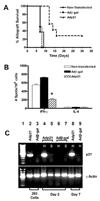Regulation of alloimmune Th1 responses by the cyclin-dependent kinase inhibitor p21 following transplantation
- PMID: 18291261
- PMCID: PMC2423232
- DOI: 10.1016/j.surg.2007.09.040
Regulation of alloimmune Th1 responses by the cyclin-dependent kinase inhibitor p21 following transplantation
Abstract
Background: The cyclin-dependent kinase (cdk) inhibitor p21 inhibits cellular proliferation of many cell types, including T cells. Autoimmune models, however, have yielded conflicting results regarding the role of cdk inhibitors and T-cell function. The role of p21 in T-cell function after transplantation has not been investigated directly. We hypothesized that p21 plays an important role in alloantigen-driven responses in vitro in mixed lymphocyte cultures (MLC) and in vivo using the heterotopic murine cardiac allograft model.
Methods: Wild type (WT) and p21-deficient (p21-/-) mice were used as recipients, and the effects of p21 overexpression were assessed by transplanting p21 adenoviral-transfected cardiac allografts. Enzyme-linked immunospot (ELISPOT) and 3H-thymidine incorporation were used to evaluate for T-cell priming and proliferation in vitro, whereas graft histology was evaluated for rejection.
Results: When stimulated with alloantigens in vitro, splenocytes from p21-/- mice mounted enhanced proliferative responses and decreased Th2 responses relative to their WT counterparts. No differences in Th1 responses were noted when p21-/- cells were stimulated with alloantigens in vitro; however, after cardiac transplantation, Th1 responses were enhanced in p21-/- recipients relative to WT mice. This enhanced in vivo Th1 response was associated with exacerbated graft rejection in p21-/- recipients. Interestingly, p21 transfection of WT allografts inhibited graft rejection and Th1 priming.
Conclusions: p21 controls the intensity of the immune response posttransplantation, with overexpression inhibiting allograft rejection. Our data demonstrate that p21 controls T-cell priming and suggest that p21 and other cdk inhibitors may serve as potential targets for therapeutic manipulation of alloimmune responses.
Figures


Similar articles
-
Interleukin-12 (IL-12)-driven alloimmune responses in vitro and in vivo: requirement for beta1 subunit of the IL-12 receptor.Transplantation. 1999 Jun 15;67(11):1453-60. doi: 10.1097/00007890-199906150-00011. Transplantation. 1999. PMID: 10385085
-
Graft rejection mediated by CD4+ T cells via indirect recognition of alloantigen is associated with a dominant Th2 response.Eur J Immunol. 2005 Mar;35(3):843-51. doi: 10.1002/eji.200425685. Eur J Immunol. 2005. PMID: 15714582
-
Transfusion of polarized TH2-like cell populations into SCID mouse cardiac allograft recipients results in acute allograft rejection.Transplantation. 1996 Jul 27;62(2):229-38. doi: 10.1097/00007890-199607270-00014. Transplantation. 1996. PMID: 8755821
-
Th17 cells and transplant acceptance.Transplantation. 2010 Nov 15;90(9):945-8. doi: 10.1097/TP.0b013e3181f5c3de. Transplantation. 2010. PMID: 20838278 Free PMC article. Review.
-
Novel immune regulatory pathways and their role in immune reconstitution syndrome in organ transplant recipients with invasive mycoses.Eur J Clin Microbiol Infect Dis. 2008 Jun;27(6):403-8. doi: 10.1007/s10096-008-0461-2. Epub 2008 Jan 23. Eur J Clin Microbiol Infect Dis. 2008. PMID: 18214557 Free PMC article. Review.
Cited by
-
Azacitidine Mitigates Graft-versus-Host Disease via Differential Effects on the Proliferation of T Effectors and Natural Regulatory T Cells In Vivo.J Immunol. 2017 May 1;198(9):3746-3754. doi: 10.4049/jimmunol.1502399. Epub 2017 Mar 22. J Immunol. 2017. PMID: 28330901 Free PMC article.
-
Immunoengineered MXene nanosystem for mitigation of alloantigen presentation and prevention of transplant vasculopathy.Nano Today. 2023 Feb;48:None. doi: 10.1016/j.nantod.2022.101706. Nano Today. 2023. PMID: 37187503 Free PMC article.
-
Engendering allograft ignorance in a mouse model of allogeneic skin transplantation to the distal hind limb.Ann Surg. 2015 Mar;261(3):611-8. doi: 10.1097/SLA.0000000000000572. Ann Surg. 2015. PMID: 24509194 Free PMC article.
References
-
- Balomenos D, Martin-Caballero J, Garcia MI, Prieto I, Flores JM, Serrano M, et al. The cell cycle inhibitor p21 controls T-cell proliferation and sex-linked lupus development. Nat Med. 2000;6(2):171–176. - PubMed
-
- Santiago-Raber ML, Lawson BR, Dummer W, Barnhouse M, Koundouris S, Wilson CB, et al. Role of cyclin kinase inhibitor p21 in systemic autoimmunity. J Immunol. 2001;167(7):4067–4074. - PubMed
-
- Nourse J, Firpo E, Flanagan WM, Coats S, Polyak K, Lee MH, et al. Interleukin-2-mediated elimination of the p27Kip1 cyclin-dependent kinase inhibitor prevented by rapamycin. Nature. 1994;372(6506):570–573. - PubMed
-
- Sherr CJ. G1 phase progression: cycling on cue. Cell. 1994;79(4):551–555. - PubMed
-
- Sherr CJ, Roberts JM. CDK inhibitors: positive and negative regulators of G1 - phase progression. Genes Dev. 1999;13(12):1501–1512. - PubMed
Publication types
MeSH terms
Substances
Grants and funding
LinkOut - more resources
Full Text Sources
Other Literature Sources
Medical

